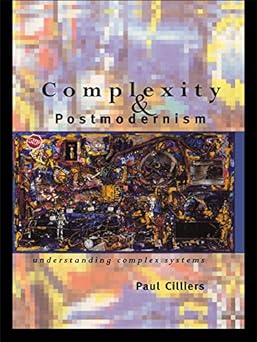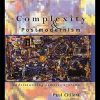Complexity and Postmodernism: Understanding Complex Systems
£31.60
In Complexity and Postmodernism, Paul Cilliers explores the idea of complexity in the light of contemporary perspectives from philosophy and science. Cilliers offers us a unique approach to understanding complexity and computational theory by integrating postmodern theory (like that of Derrida and Lyotard) into his discussion. Complexity and Postmodernism is an exciting and an original book that should be read by anyone interested in gaining a fresh understanding of complexity, postmodernism and connectionism.
Read more
Additional information
| Publisher | 1st edition (11 Sept. 2002), Routledge |
|---|---|
| Language | English |
| File size | 1305 KB |
| Simultaneous device usage | Up to 4 simultaneous devices, per publisher limits |
| Text-to-Speech | Enabled |
| Enhanced typesetting | Enabled |
| X-Ray | Not Enabled |
| Word Wise | Enabled |
| Sticky notes | On Kindle Scribe |
| Print length | 164 pages |
| Page numbers source ISBN | 0415152879 |






by Incognito
Disclaimer: I’m not a philosopher, nor am I a physicist, so I can’t really appreciate merits of harsh reviews from these perspectives on American Amazon. But I consider myself being a specialist in enterprise software and a systems engineer, so what follows would be probably relevant only to people of my trade.
In his book Paul Cilliers explores various aspects of complex systems, in particular self-organization and capacity to reflect the external world. What makes it interesting from my perspective is that the author postulates that a neural network is superior model for a complex system when compared with predicate-based models. This may sound odd, but the use of this rather surprising approach is well-justified and enables the author to make interesting conclusions from the wealth of theoretical and practical results available in the field of neural networks.
The property of self-organization is said to be enabled by the system being on the verge between active (self-inducing) and passive (balancing) stances, and the true self-organization is only possible when there’s a proper balance between cooperation and competition among elements, which is exactly the case for large scale neural networks, such as, arguably, our neural system.
However, the most interesting part of the book is the discussion about representation of the external world within a complex system. It is deemed to be a critical property of any complex system. An open system without representation capacity is unable to anticipate and react to upcoming changes that would eventually tear it off.
Paul Cilliers argues that a predicate-based approach is inferior for representing complex reality. Instead, the author looks at the problem from the perspective of post-modernist (in particular, post-structuralist) philosophical school. In particular, he drew a lot from the understanding of a natural language that is pioneered by Jacques Derrida, who opposed the school of structural linguistics, originating from works of Ferdinand de Saussure. Derrida denied the existence of an independent and abstract semantics layer within a natural language, and according to him a meaning of a word could only be defined by (deferred to) the sum of relationship with other words in a language. It is demonstrated that Derrida’s model of the way natural language represents the reality is analogous to the way a neural network solves a problem. The author draws an analogy between predicate-based modelling approach and structural linguistics and then concludes that post-structuralist approach based on the distributed representation is superior to the former for the purpose of representing complex and ambiguous reality.
This is quite interesting perspective with a lot of practical implications. For example, a prominent corollary for post-structuralist view is that it is impossible to construct a single consistent description of the reality (meta or grand narrative). That gives a new rather refreshing perspective on systems integration approaches based on a grand narrative of unified semantics such as ISO 15926, which may actually fail to deliver not because of some technical issues that eventually will be resolved, but because of violating the laws of the representation of reality.
Surprisingly, despite addressing sophisticated matters the prose of the book is easy to follow, well though-out, and rather convincing, but to be honest, I’ve skipped most of the last chapter that covers various aspects of the philosophy of science, as I’m lacking background that is necessary to make sense out of it.
In summary, being deeply anchored in IT, the book is definitely well worth reading for any IT specialist, especially those who deal with applications integration and architecture.
(This review was originally posted on Enterprise Systems Engineering blog — see profile for URL)